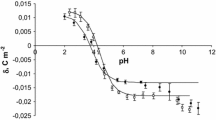Summary
Pulsed nuclear magnetic resonance spectroscopy is employed to determine the time dependence of the change in erythrocyte water permeability following exposure top-chloromercuribenzoate (PCMB) orp-chloromercuribenzene sulfonic acid (PCMBS). pH variation was used to examine the environment of the sulfhydryl groups reactive to these drugs. PCMB reacted with at least two sulfhydryl groups which affect water permeability. This was shown by the double exponential character of the change in erythrocyte diffusional permeability with time after PCMB addition. However, only one inhibition rate process could be distinguished following PCMBS exposure, suggesting that one site bound by PCMB is not accessible to PCMBS. This site is postulated to be located in a hydrophobic region of the membrane, whereas the site reached by both drugs is located in the normal anion permeation channel. The effect of pH on the degree of inhibition due to each component and the inhibition rates is explained in terms of its effect on solubility of the reagents in the membrane and variation of the dissociated-to-undissociated ratio of PCMB.
Similar content being viewed by others
References
Benesch, R., Benesch, R.E. 1962. Determination of SH groups in proteins.In: Methods of Biochemical Analysis. D. Glick, editor. Vol. 10, pp. 43–70. Interscience, New York
Brown, P.A., Feinstein, M.B., Sha'afi, R.I. 1975. Membrane proteins related to water transport in human erythrocytes.Nature (London) 254:523–525
Carr, H.Y., Purcell, E.M. 1954. Effects of diffusion on free precession in nuclear magnetic resonance experiments.Phys. Rev. 94:630–638
Chien, D.Y., Macey, R.I. 1977. Diffusional water permeability of red cells. Independence on osmolality.Biochim. Biophys. Acta 464:45–52
Conlon, T., Outhred, R. 1978. The temperature dependence of erythrocyte water diffusion permeability.Biochim. Biophys. Acta 511:408–418
Fabry, M.E., Eisenstadt, M. 1975. Water exchange between red cells and plasma.Biophys. J. 15:1101–1110
Forster, R.E. 1971. The transport of water in erythrocytes.Curr. Top. Membr. Trans. 2:41–98
Giberman, E. 1973. Determination of the trapped volume in a pellet of red blood cells.Experientia 29:1083–1085
Godin, D.V., Schrier, S.L. 1972. Modification of the erythrocyte membrane by sulfhydryl group reagents.J. Membrane Biol. 7:285–312
Hazelwood, C.F., Chang, D.C., Nichols, B.L., Woessner, D.E. 1974. Nuclear magnetic resonance transverse relaxation times of water protons in skeletal muscle.Biophys. J. 14:583–606
Jacobs, H.S., Jandl, J.H. 1962. Effects of sulfhydryl inhibition on red blood cells. I. Mechanism of hemolysis.J. Clin. Invest. 41:779–792
Knauf, P.A., Rothstein, A. 1971. Chemical modification of membranes. I. Effects of sulfhydryl and amino reactive reagents on anion and cation permeability of the human red blood cell.J. Gen. Physiol. 58:190–210
Knauf, P.A., Rothstein, A. 1971. Chemical modification of membranes. II. Permeation paths for sulfhydryl agents.J. Gen. Physiol. 58:211–223
Liu, S., Fairbanks, G., Palek, J. 1977. Spontaneous, reversible protein cross-linking in the human erythrocyte membrane. Temperature and pH dependence.Biochemistry 16:4066–4074
Macey, R.I., Farmer, R.E.L. 1970. Inhibition of water and solute permeability in human red cells.Biochim. Biophys. Acta 211:104–106
Macey, R.I., Karan, D.M., Farmer, R.E.L. 1972. Properties of water channels in human red cells.In: Passive Permeability of Cell Membranes. F. Kreuzer and J.F.G. Slegers, editors. pp. 331–340. Plenum, New York
Meiboom, S., Gill, D. 1958. Modified spin-echo method for measuring nuclear relaxation times.Rev. Sci. Instr. 29:688–691
Naccache, P., Sha'afi, R.I. 1974. Effect of PCMBS on water transfer across biological membranes.J. Cell. Physiol. 83:449–456
Pirkle, J.L., Ashley, D.L., Goldstein, J.H. 1979. Pulse nuclear magnetic resonance measurements of water exhange across the erythrocyte membrane employing a low Mn concentration.Biophys. J. 25:389–406
Provencher, S.W. 1976. A Fourier method for the analysis of exponential decay curves.Biophys. J. 16:27–41
Rich, G.T., Sha'afi, R.I., Romualdez, A., Solomon, A.K. 1968. Effect of osmolality on the hydraulic permeability coefficient of red cells.J. Gen. Physiol. 52:941–954
Rothstein, A. 1970. Sulfhydryl groups in membrane structure and function.In: Current Topics in Membranes and Transport. F. Bronner and A. Kleinzeller, editors, Vol. 1; pp. 135–176. Academic Press, New York
Rothstein, A., Takeshita, M., Knauf, P.A., 1972. Chemical modification of proteins involved in the permeability of the erythrocyte membrane to ions.In: Passive Permeability of Cell Membranes. F. Kreuzer and J.F.G. Slegers, editors. pp. 393–413. Plenum Press, New York
Sandberg, H.E., Bryant, R.G., Piette, L.H. 1969. Studies on the location of sulfhydryl groups in erythrocyte membranes with magnetic resonance spin probes.Arch. Biochem. Biophys. 133:144–152
Sha'afi, R.I. 1977. Water and nonelectrolyte permeation in red cells.In: Membrane Transport in Red Cells. J.C. Ellory and V.L. Lew, editors, pp. 221–256. Academic Press, New York
Smith, B.D., Lacelle, P.L. 1979. Parallel decrease of erythrocyte membrane deformability and spectrin solubility at low pH.Blood 53:15–18
Sutherland, R.M., Rothstein, A., Weed, R.I. 1969. Erythrocyte membrane sulfhydryl groups and cation permeability.J. Cell. Physiol. 69:185–198
VanSteveninck, J., Weed, R.I., Rothstein, A. 1965. Localization of erythrocyte membrane sulfhydryl groups essential for glucose transport.J. Gen. Physiol. 48:617–632
Weed, R.I., Rothstein, A. 1960. The uptake of divalent manganese ion by mature normal human red blood cells.J. Gen. Physiol. 44:301–314
Author information
Authors and Affiliations
Rights and permissions
About this article
Cite this article
Ashley, D.L., Goldstein, J.H. Time dependence of the effect ofp-chloromercuribenzoate on erythrocyte water permeability: A pulsed nuclear magnetic resonance study. J. Membrain Biol. 61, 199–207 (1981). https://doi.org/10.1007/BF01870524
Received:
Revised:
Issue Date:
DOI: https://doi.org/10.1007/BF01870524




